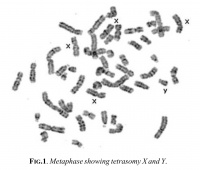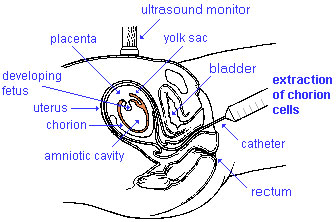Trisomy X
| Embryology - 27 Apr 2024 |
|---|
| Google Translate - select your language from the list shown below (this will open a new external page) |
|
العربية | català | 中文 | 中國傳統的 | français | Deutsche | עִברִית | हिंदी | bahasa Indonesia | italiano | 日本語 | 한국어 | မြန်မာ | Pilipino | Polskie | português | ਪੰਜਾਬੀ ਦੇ | Română | русский | Español | Swahili | Svensk | ไทย | Türkçe | اردو | ייִדיש | Tiếng Việt These external translations are automated and may not be accurate. (More? About Translations) |
| ICD-11 |
|---|
LD50.1 Karyotype 47,XXX
|
Introduction

Trisomy X is a caused by the presence of an extra X chromosome in females (47,XXX instead of 46,XX). This is also the most common female chromosomal abnormality, occurring in approximately 1 in 1,000 female births.
Other abnormalities of chromosome number include: female tetrasomy X (quadruple X, or 48, XXXX) a rare chromosomal disorder and male Klinefelter syndrome, the presence of an additional X chromosome (47, XXY or XXY).
- Alternative names: Triplo X syndrome, Trisomy X, 47,XXX, XXX syndrome
Genital System - Abnormalities
Some Recent Findings
|
| More recent papers |
|---|
|
This table allows an automated computer search of the external PubMed database using the listed "Search term" text link.
More? References | Discussion Page | Journal Searches | 2019 References | 2020 References Search term: Trisomy X |
| Older papers |
|---|
| These papers originally appeared in the Some Recent Findings table, but as that list grew in length have now been shuffled down to this collapsible table.
See also the Discussion Page for other references listed by year and References on this current page.
|
Prenatal Diagnosis
Trisomy X Karyotype[8]
The most common prenatal diagnosis is by either amniocentesis or chorionic villi sampling.
Physical Features
| Feature | Estimated frequency |
|---|---|
| Tall stature >75th percentile | 80 - 89 % |
| Epicanthal folds | 32 - 46 % |
| Clinodactyly | 42 - 65 % |
| Hypotonia in infancy | 55 - 71 % |
| Genitourinary malformations | 5 - 16 % |
| Seizure disorder | 11 - 15 % |
| Intention tremor | 6 - 20 % |
| Congenital hip dysplasia | 2 - 12 % |
| Constipation/Abdominal pains | 12 - 45 % |
| Premature ovarian failure | unknown |
| Table data source[6] | |
Tetrasomy X
| Tetrasomy X is due to two non-disjunction events in maternal oocyte meiosis. Tetrasomy X (48, XXXX) is a rare female disorder associated with: facial dysmorphism, premature ovarian insufficiency[9] and intellectual disability.[10] A single case study has shown the presence of a Rathke's cleft cyst (RCC).[11] Tetrasomy X in males (49, XXXXY) is a similarly rare sex chromosome aneuploidy with associated limb abnormalities.[12] | 
Male tetrasomy X karyotype[12] |
References
- ↑ Venkateshwari A, Srimanjari K, Srilekha A, Begum A, Sujatha M, Sunitha T, Nallari P & Jyothy A. (2012). Mosaic triple X syndrome in a female with primary amenorrhea. Indian J Hum Genet , 18, 246-9. PMID: 23162306 DOI.
- ↑ Singhal P, Singh S, Kumar P & Naredi N. (2021). Premature Ovarian Failure Related to Trisomy X: Two Case Reports with an Aberrant 47, XXX Karyotype. J Hum Reprod Sci , 14, 87-90. PMID: 34083998 DOI.
- ↑ Gruchy N, Blondeel E, Le Meur N, Joly-Hélas G, Chambon P, Till M, Herbaux M, Vigouroux-Castera A, Coussement A, Lespinasse J, Amblard F, Jimenez Pocquet M, Lebel-Roy C, Carré-Pigeon F, Flori E, Mugneret F, Jaillard S, Yardin C, Harbuz R, Collonge-Rame MA, Vago P, Valduga M, Leporrier N & Vialard F. (2016). Pregnancy outcomes in prenatally diagnosed 47, XXX and 47, XYY syndromes: a 30-year French, retrospective, multicentre study. Prenat. Diagn. , 36, 523-9. PMID: 27018091 DOI.
- ↑ Stagi S, di Tommaso M, Scalini P, Lapi E, Losi S, Bencini E, Masoni F, Dosa L, Becciani S & de Martino M. (2016). Triple X syndrome and puberty: focus on the hypothalamus-hypophysis-gonad axis. Fertil. Steril. , 105, 1547-53. PMID: 26952785 DOI.
- ↑ Lenroot RK, Blumenthal JD, Wallace GL, Clasen LS, Lee NR & Giedd JN. (2014). A case-control study of brain structure and behavioral characteristics in 47,XXX syndrome. Genes Brain Behav. , 13, 841-9. PMID: 25287572 DOI.
- ↑ 6.0 6.1 Tartaglia NR, Howell S, Sutherland A, Wilson R & Wilson L. (2010). A review of trisomy X (47,XXX). Orphanet J Rare Dis , 5, 8. PMID: 20459843 DOI.
- ↑ Lähdesmäki RE & Alvesalo LJ. (2010). Root length in the permanent teeth of women with an additional X chromosome (47,XXX females). Acta Odontol. Scand. , 68, 223-7. PMID: 20568965 DOI.
- ↑ Kodandapani S, Pai MV, Nambiar J & Moka R. (2011). Premature ovarian aging in primary infertility: Triple X syndrome. J Hum Reprod Sci , 4, 153-4. PMID: 22346085 DOI.
- ↑ Kara C, Üstyol A, Yılmaz A, Altundağ E & Oğur G. (2014). Premature ovarian failure due to tetrasomy X in an adolescent girl. Eur. J. Pediatr. , 173, 1627-30. PMID: 24221609 DOI.
- ↑ Samango-Sprouse C, Keen C, Mitchell F, Sadeghin T & Gropman A. (2015). Neurodevelopmental variability in three young girls with a rare chromosomal disorder, 48, XXXX. Am. J. Med. Genet. A , 167A, 2251-9. PMID: 26086740 DOI.
- ↑ Uppal S, Jee YH, Lightbourne M, Han JC & Stratakis CA. (2017). Combined pituitary hormone deficiency in a girl with 48, XXXX and Rathke's cleft cyst. Hormones (Athens) , 16, 92-98. PMID: 28500832 DOI.
- ↑ 12.0 12.1 Korgaonkar S & Vundinti BR. (2015). Tetrasomy X in a Child with Upper Limb Deformity. Indian Pediatr , 52, 439. PMID: 26061938
Reviews
Tartaglia NR, Howell S, Sutherland A, Wilson R & Wilson L. (2010). A review of trisomy X (47,XXX). Orphanet J Rare Dis , 5, 8. PMID: 20459843 DOI.
Visootsak J & Graham JM. (2006). Klinefelter syndrome and other sex chromosomal aneuploidies. Orphanet J Rare Dis , 1, 42. PMID: 17062147 DOI.
Articles
Brambila-Tapia AJ, Rivera H, García-Castillo H, Domínguez-Quezada MG & Dávalos-Rodríguez IP. (2009). 47,XXX/45,X/46,XX mosaicism in a patient with Turner phenotype and spontaneous puberal development. Fertil. Steril. , 92, 1747.e5-7. PMID: 19732877 DOI.
Lester T, de Alwis M, Clark PA, Jones AM, Katz F, Levinsky RJ & Kinnon C. (1994). Trisomy X in a female member of a family with X linked severe combined immunodeficiency: implications for carrier diagnosis. J. Med. Genet. , 31, 717-20. PMID: 7815443
Tennes K, Puck M, Bryant K, Frankenburg W & Robinson A. (1975). A developmental study of girls with trisomy X. Am. J. Hum. Genet. , 27, 71-80. PMID: 1155452
JOHNSTON AW, FERGUSON-SMITH MA, HANDMAKER SD, JONES HW & JONES GS. (1961). The triple-X syndrome. Clinical, pathological, and chromosomal studies in three mentally retarded cases. Br Med J , 2, 1046-52. PMID: 14452136
Search PubMed
Search Pubmed: Trisomy X
External Links
External Links Notice - The dynamic nature of the internet may mean that some of these listed links may no longer function. If the link no longer works search the web with the link text or name. Links to any external commercial sites are provided for information purposes only and should never be considered an endorsement. UNSW Embryology is provided as an educational resource with no clinical information or commercial affiliation.
- Genetics Home Reference triple X syndrome
Glossary Links
- Glossary: A | B | C | D | E | F | G | H | I | J | K | L | M | N | O | P | Q | R | S | T | U | V | W | X | Y | Z | Numbers | Symbols | Term Link
Cite this page: Hill, M.A. (2024, April 27) Embryology Trisomy X. Retrieved from https://embryology.med.unsw.edu.au/embryology/index.php/Trisomy_X
- © Dr Mark Hill 2024, UNSW Embryology ISBN: 978 0 7334 2609 4 - UNSW CRICOS Provider Code No. 00098G



